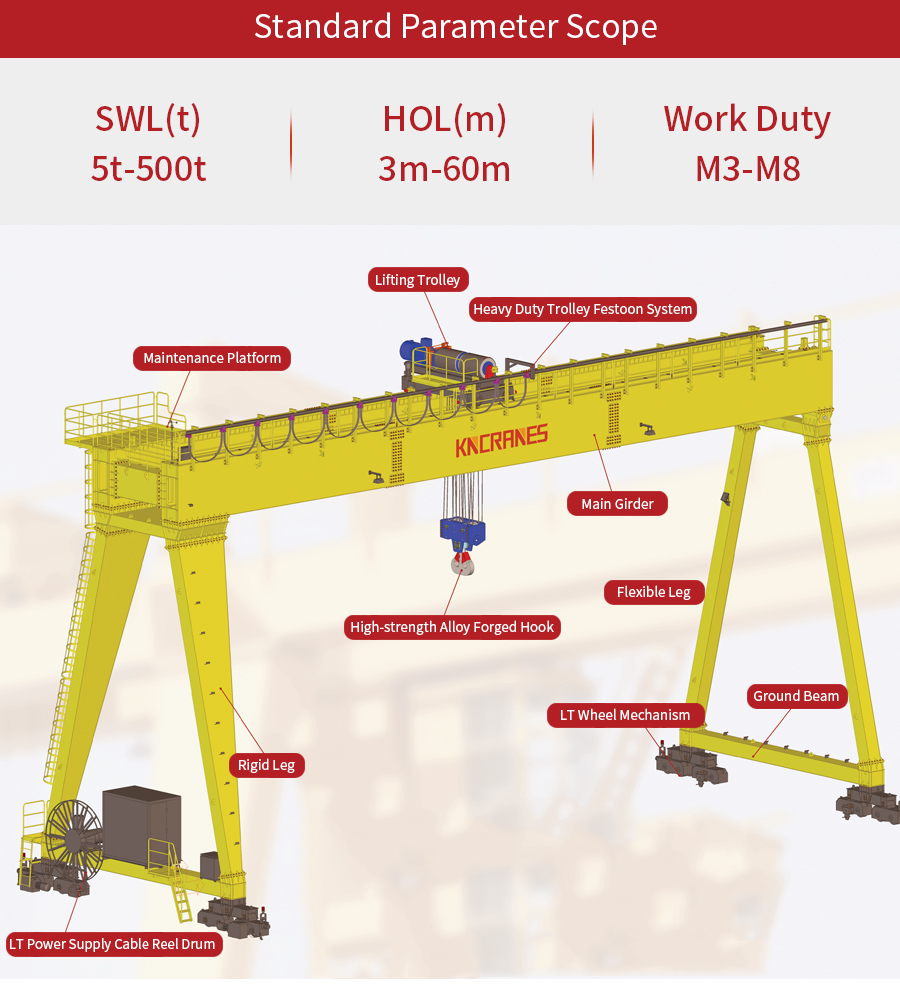WhatsApp: +8619037303916
Email: [email protected]
WhatsApp: +8619037303916
Email: [email protected]

When a buyer or user is looking to purchase a gantry crane, they will need to provide the manufacturer with specific technical parameters such as lifting capacity, span length, lifting height, material being lifted, and working environment. This information will help the manufacturer to determine which type of gantry crane is best suited for the buyer's needs.
In addition, understanding the components of a gantry crane is important in helping the buyer or user to understand how the crane works and what features are necessary for their specific application. The main components of a gantry crane include the main girder, cantilever (if applicable), supporting legs, trolley, driver's cabin, lifting wire rope, hook, and other optional features such as anemometers and lightning rods for windy environments.
Once the manufacturer has all of the necessary information about the buyer's requirements, they can provide a suitable gantry crane solution and quotation that meets the buyer's needs.
Here is a breakdown of the main components of a heavy-duty double girder gantry crane:

1. Main Girder: The main girder is the long horizontal structure that spans the width of the gantry crane. It is usually made of steel and supports the hoist trolley and the load being lifted.
2. Ground Beam: The ground beam is a structural element that provides stability to the gantry crane. It is usually made of steel or concrete and is anchored to the ground.
3. Flexible Leg: The flexible leg is a type of supporting leg that can adjust to uneven terrain or slopes. It is usually made of steel and can be adjusted to different heights.
4. Rigid Leg: The rigid leg is a type of supporting leg that is fixed in place and cannot adjust to different heights. It is usually made of steel and provides stability to the gantry crane.
5. LT Wheel Mechanism: The LT wheel mechanism is the mechanism that allows the gantry crane to move along the tracks. It is usually powered by an electric motor and can move in a straight line or turn at a certain angle.
6. LT Power Supply Cable Reel Drum: The LT power supply cable reel drum is the mechanism that supplies power to the gantry crane, used to prevent the cable from getting tangled.
7. Lifting Trolley: The lifting trolley is the mechanism that moves along the main girder and supports the hoist. It is typically powered by an electric motor and is used to position the load.
8. Maintenance Platform: The maintenance platform is a platform that provides access to the various components of the gantry crane for maintenance and repairs.
9. Driver's Cabin: The driver's cabin is the control room where the crane operator sits and controls the movements of the gantry crane.
10. Lifting Wire Rope: The lifting wire rope is the cable or rope that is used to lift and lower the load. It is attached to the hoist and the hook.
11. Hook: The hook is the mechanism that is attached to the end of the lifting wire rope and is used to pick up and move the load.
Other optional features that can be included with a heavy-duty gantry crane include anti-collision devices, remote control systems, and various safety features such as limit switches and overload protection systems.
In conclusion, gantry cranes are complex machines with various components and configurations that are tailored to specific lifting requirements. Knowing the main components of a gantry crane is essential for understanding how the machine works and for communicating with gantry crane manufacturers when requesting a quotation. Whether it's for heavy-duty industrial applications or light-duty projects, choosing the right gantry crane for the job can save time, increase productivity, and ensure the safety of the operators and the load being lifted.
TO TOP